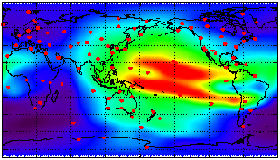

Ionospheric Storms
Solar activity such as flares and coronal mass ejections often produce large variations in the particle and electromagnetic radiation incident upon the earth. Such variations can, in turn, lead to disturbances of the "quiet-time" magnetosphere and ionosphere.
These disturbances, when affecting the ionosphere are known as ionospheric storms, tend to generate large disturbances in ionospheric density distribution, total electron content, and the ionospheric current system. Ionospheric storms have important terrestrial consequences such as disrupting satellite communications and interrupting the flow of electrical energy over power grids.
They also provide the most challenging conditions under which accurate assessment of the vertical delay calibrations, to be used in the WAAS aircraft navigation system, must be maintained. Thus, it is important to monitor such storms, and, if possible, forecast their evolution.
Monitoring and Nowcasting Ionospheric Storms Using the Global GPS Network
The ability to use the global GPS network to generate global maps of the ionosphere's total electron content (TEC) in near real-time presents us with a new and powerful tool for not only detecting ionospheric storms and monitoring their behavior, but also for pursuing scientific research that will lead to a more complete understanding of storm phenomena. A differential mapping technique (DMT) has been developed, which makes it possible to identify, characterize, and classify storms by distinguishing storm-time variations of the ionosphere from quiet-time variations. What is unprecedented in this approach is the ability to study ionospheric storms on simultaneous world-wide scales in near real-time.